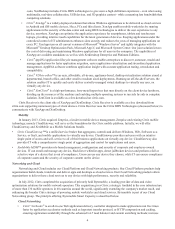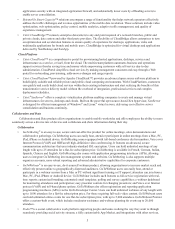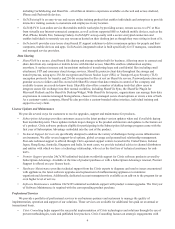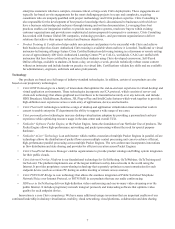Citrix 2012 Annual Report Download - page 18
Download and view the complete annual report
Please find page 18 of the 2012 Citrix annual report below. You can navigate through the pages in the report by either clicking on the pages listed below, or by using the keyword search tool below to find specific information within the annual report.14
ITEM 1A. RISK FACTORS
Our operating results and financial condition have varied in the past and could in the future vary significantly depending
on a number of factors. From time to time, information provided by us or statements made by our employees contain “forward-
looking” information that involves risks and uncertainties. In particular, statements contained in this Annual Report on Form
10-K for the year ended December 31, 2012, and in the documents incorporated by reference into this Annual Report on Form
10-K for the year ended December 31, 2012, that are not historical facts, including, but not limited to, statements concerning
new products, product development and offerings of products and services, market positioning, distribution and sales channels,
our partners and other strategic or technology relationships, financial information and results of operations for future periods,
product and price competition, strategy and growth initiatives, seasonal factors, natural disasters, stock-based compensation,
licensing and subscription renewal programs, international operations and expansion, investment transactions and valuations of
investments and derivative instruments, reinvestment or repatriation of foreign earnings, fluctuations in foreign exchange rates,
tax matters, acquisitions, stock repurchases, changes in accounting rules or guidance, changes in domestic and foreign
economic conditions and credit markets, delays or reductions in technology purchases, liquidity, litigation matters, and
intellectual property matters constitute forward-looking statements and are made under the safe harbor provisions of
Section 27A of the Securities Act of 1933, as amended, and Section 21E of the Securities Exchange Act of 1934, as amended.
These statements are neither promises nor guarantees. Our actual results of operations and financial condition could vary
materially from those stated in any forward-looking statements. The following factors, among others, could cause actual results
to differ materially from those contained in forward-looking statements made in this Annual Report on Form 10-K for the year
ended December 31, 2012, in the documents incorporated by reference into this Annual Report on Form 10-K or presented
elsewhere by our management from time to time. Such factors, among others, could have a material adverse effect upon our
business, results of operations and financial condition. We caution readers not to place undue reliance on any forward-looking
statements, which only speak as of the date made. We undertake no obligation to update any forward-looking statement to
reflect events or circumstances after the date on which such statement is made.
RISKS RELATED TO OUR BUSINESS AND INDUSTRY
Our business could be adversely impacted by conditions affecting the information technology market.
The demand for our products and services depends substantially upon the general demand for business-related computer
appliances and software, which fluctuates based on numerous factors, including capital spending levels, the spending levels and
growth of our current and prospective customers, and general economic conditions. Moreover, the purchase of our products is
often discretionary and may involve a significant commitment of capital and other resources. Future economic projections for
the information technology sector are uncertain as companies continue to reassess their spending for technology projects. If our
current and prospective customers engage in restructuring and other efforts to cut costs they may significantly reduce their
information technology expenditures. Fluctuations in the demand for our products and services could have a material adverse
effect on our business, results of operations and financial condition.
If we do not develop new products and services, integrate acquired products and services and enhance our existing products
and services, our business, results of operations and financial condition could be adversely affected.
The markets for our products and services are characterized by:
• rapid technological change;
• evolving industry standards;
• fluctuations in customer demand;
• changes in customer requirements; and
• frequent new product and service introductions and enhancements.
Our future success depends on our ability to continually enhance our current products and services, integrate acquired
products and services, and develop and introduce new products and services that our customers choose to buy. The emerging
markets for our next generation of products and services have yet to be defined. If we are unable to keep pace with
technological developments, expectations of the emerging markets and customer demands by introducing new products and
services and enhancements, our business, results of operations and financial condition could be adversely affected. Our future
success could be hindered by:
• delays in our introduction of new products and services;
• delays in market acceptance of new products and services or new releases of our current products and services;
• our failure to maintain relevance in the evolving marketplace; and
























